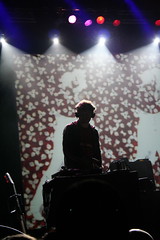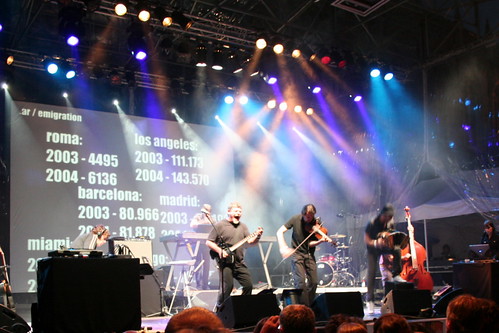Point and shoot badly
06 Aug 2007 I went to the concert of Bajofondo Tango Club in Brugge last Friday. Of course I took my Canon 350D along and shot a lot of pictures. I never use a flash for concert pictures, certainly not since I started using a 50mm f/1.8 and I can grab quite a lot of light with it. I usually use ‘Aperture priority’ mode (with aperture on 1.8, obviously) and use the automatic focus, because I’m not good enough at doing that manually. You sometimes have to wait for the right podium lights to go on, include some light spots in the frame so that your camera uses a shorter shutter but above all, you have to be lucky.
I went to the concert of Bajofondo Tango Club in Brugge last Friday. Of course I took my Canon 350D along and shot a lot of pictures. I never use a flash for concert pictures, certainly not since I started using a 50mm f/1.8 and I can grab quite a lot of light with it. I usually use ‘Aperture priority’ mode (with aperture on 1.8, obviously) and use the automatic focus, because I’m not good enough at doing that manually. You sometimes have to wait for the right podium lights to go on, include some light spots in the frame so that your camera uses a shorter shutter but above all, you have to be lucky.
The pictures that came out rather well are in my Flickr Bajofondo Tango Club album.
I did have some fun with a guy in front of me with a ‘point-and-shoot’ camera, it might have been a Canon Ixus or something. He added a twist to the common ‘people-using-a-camera-flash-from-a-distance’ error. He would see a beautiful image in his viewer, push the button and a totally awful grayish picture would show up as a result. For his sake and that of other P&S’ers, here’s two rules for using it in a concert where you’re in the audience.
Rule #1: do not use your camera flash
You have a simple small flash in your camera that might reach as far as 5m maybe, but it is of no use for a podium 20m away. Your camera will think that the subject of your photo will receive a bunch of light from it and choose a faster shutter. The light of your flash will never reach those musicians, but chances are some will fall on members of the audience that are standing nearby, so the only thing that will light up is some bald heads, a fake blonde and a lot of dandruff.
Switch the flash to ‘off’ or use the ‘landscape’ setting! If your camera permits it, set the ISO-setting to as high as 800ISO (if you own a 1000€-plus camera, 1600ISO is safe too, but you shouldn’t be reading this then). This will make the image grainier, but will make the shutter time shorter. If the scene is still too dark and your camera uses shutter times of more than 1/20 sec, try to include more light in the composition. Don’t zoom in too much, it will only make things worse. You can always crop the picture when you’re home.
Remember: when you’re using a small flash at a concert, or even worse, a mobile phone with the built-in flash from 30m away, you look like an utter amateur.
Rule #2: do not hold your finger in front of the flash
This one cracked me up: the guy in front of me held his left index finger right in front of his flash. So most of his pictures were extremely dark, with the odd one that included a completely white fragment of his finger. The only times that this wasn’t the case, was when he took pictures in portrait, turning his camera 90 degrees to the left, which brought his flash even lower and added quite some very bright shoulders to the composition.
So, if your flash photos are way too dark, and your finger feels very warm whenever you take a picture, check where the flash sits on your compact camera and make sure you put no bodily parts in front of it.
